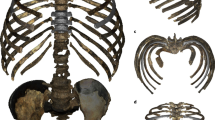Abstract
The specimen KNM-WT 15000 is an exceptionally complete 1.53 Myr juvenile skeleton of Homo erectus from West Turkana, Kenya. It therefore provides a unique opportunity to examine stature estimates of fossil hominids based strictly on long bone lengths. Using recovered axial and appendicular elements of KNM-WT 15000 that contributed to stature during life, we conclude that KNM-WT 15000 was much shorter at time-of-death than previous estimates that used only appendicular elements. We conservatively estimate stature-at-death at about 147 cm, although this individual could have been as short as 141 cm. Because long bone based estimates of stature also imply the axial skeletal proportion, our new stature estimate stems from the recognition of axial/appendicular disproportion in the individual KNM-WT 15000. It is possible that the peripubescent age-at-death of this specimen, and any resulting differential maturity between the appendicular and axial skeleton, may have contributed to previous overestimates of stature-at-death. However, the possibility that this individual was abnormal, as implied by axial/appendicular disproportion, remains to be fully tested. Regardless, these results suggest that some interpretations of the biology of early African Homo erectus, largely based upon KNM-WT 15000, should be viewed with caution.
Similar content being viewed by others
References
Allbrook D (1961) The estimation of stature in British and East African males. Journal of Forensic Medicine 8:15–28.
Brown F, Harris J, Leakey R, and Walker A (1985) Early Homo erectus skeleton from west Lake Turkana, Kenya. Nature 316:788–792.
Brown FH, and McDougall I (1993) Geologic setting and age. In A Walker and R Leakey (eds.): The Nariokotome Homo erectus Skeleton. Cambridge: Harvard University Press, pp. 9–20.
Clegg M, and Aiello LC (1999) A comparison of the Nariokotome Homo erectus with juveniles from a modern human population. American Journal of Physical Anthropology 110:81–93.
Cook DC, Buikstra JE, DeRousseau CJ, and Johanson DC (1983) Vertebral pathology in the Afar australopithecines. American Journal of Physical Anthropology 60:83–1011.
Feldesman MR, and Lundy JK (1988) Stature estimates for some African Plio-Pleistocene hominids. Journal of Human Evolution 17:583–596.
Flügel B, Greil H, and Sommer K (1986) Anthropologischer Atlas. Grundlagen und Daten. Alters- und Geschlechtsvariabilität des Menschen. Frankfurt/Main: Edition Wötzel.
Fully G (1956) Une nouvelle méthode de détermination de la taille. Ann. Med. Leg. Criminol. 35:266–273.
Hens SM, Konigsberg LW, and Jungers WL (1998) Estimation of African ape body length from femur length. Journal of Human Evolution 34:401–411.
Johanson DC, Lovejoy CO, Kimbel WH, White TD, Ward SC, Bush ME, Latimer BM, and Coppens Y (1982) Morphology of the Pliocene partial hominid skeleton (A.L. 288-1) from the Hadar Formation, Ethiopia. American Journal of Physical Anthropology 57:403–451.
Latimer B, and Ward CV (1993) The thoracic and lumbar vertebrae. In A Walker and R Leakey (eds.): The Nariokotome Homo erectus Skeleton. Cambridge: Harvard University Press, pp. 266–293.
Latimer B, and Ohman JC, (2001) Axial dysplasia inHomo erectus. Journal of Human Evolution 40:A12 (abstract).
Lundy JK (1983) Regression equations for estimating living stature from long limb bones in the South African Negro. South African Journal of Science 79:337–338.
Lundy JK (1984) Selected Aspects of Metrical and Morphological Infracranial Skeletal Variation in the South African Negro. Ph.D., University of the Witwatersrand, Johannesburg.
Lundy JK, and Feldesman MR (1987) Revised equations for estimating living stature from long limb bones in the South African Negro. South African Journal of Science 83:54–55.
Pearson K (1899) Mathematical contributions to the theory of evolution. — V. On the reconstruction of the stature of prehistoric races. Philosophical Transactions of the Royal Society, London (Series A) 192:169–244.
Robinson JT (1972) Early Hominid Posture and Locomotion. Chicago: The University of Chicago Press.
Ruff CB, and Walker A (1993) Body size and body shape. In A Walker and R Leakey (eds.): The Nariokotome Homo erectus Skeleton. Cambridge: Harvard University Press, pp. 234–265.
Schmorl G, and Junghanns H (1959) The Human Spine in Health and Disease. New York: Grune & Stratton.
Smith BH (1993) The physiological age of KNM-WT 15000. In A Walker and R Leakey (eds.): The Nariokotome Homo erectus Skeleton. Cambridge: Harvard University Press, pp. 195–220.
Smith RJ (1996) Biology and body size in human evolution: Statistical inference misapplied. Current Anthropology 37:451–481.
Taylor JR (1973) Growth and Development of the Human Intervertebral Disc, University of Edinburgh, Edinburgh.
Walker A (1993) Taphonomy. In A Walker and R Leakey (eds.): The Nariokotome Homo erectus Skeleton. Cambridge: Harvard University Press, pp. 40–53.
Walker A, and Leakey R (1993a) The Nariokotome Homo erectus Skeleton. Cambridge: Harvard University Press.
Walker A, and Leakey R (1993b) The postcranial bones. In A Walker and R Leakey (eds.): The Nariokotome Homo erectus Skeleton. Cambridge: Harvard University Press, pp. 95–160.
Walker A, and Ruff CB (1993) The reconstruction of the pelvis. In A Walker and R Leakey (eds.): The Nariokotome Homo erectus Skeleton. Cambridge: Harvard University Press, pp. 221–233.
Author information
Authors and Affiliations
Additional information
5 Primate Evolution and Morphology Group, Department of Human
Rights and permissions
About this article
Cite this article
Ohman, J.C., Wood, C., Wood, B. et al. Stature-at-death of KNM-WT 15000. Hum. Evol. 17, 129–141 (2002). https://doi.org/10.1007/BF02436366
Received:
Accepted:
Issue Date:
DOI: https://doi.org/10.1007/BF02436366




